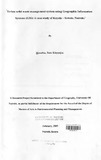| dc.description.abstract | The problem of solid waste is prevalent in Nairobi city in general, and is most acute in the low-income residential estates. It is mainly manifested in form of littering and illegal dumping in areas not designated for dumping, particularly in open, undeveloped plots. This kind of scenario poses an environmental problem as well as hazard to human
health.
The objective of the research project was to search for a solution to the problem of urban solid waste management in low-income residential areas. To achieve this, the various types of wastes generated in the study area and their quantities were determined. This
was done by actual activity of collecting and weighing waste from sampled households. The factors that interplay and affect management of solid waste and source-separation of waste were also investigated using questionnaires administered to sampled households. Emphasis was laid upon the identification of the appropriate destinations of the different types of wastes, with the aim of directing each type of waste to the rig~~1Iace for recycling, re-use or for composting. All these aided in the planning of an integrated solid waste management system.
The research revealed that organic waste was produced in large proportion (77.2%) and that most of the waste was compositable, recyclable and/or re-usable.
Once the waste types, quantities and destinations of the various wastes were determined, a spatial framework was designed using Geographical Information Systems (GIS). The factors that influence source separation of wastes helped in formulating policies that
should be put in place to minimize the magnitude of the problem. | en |

